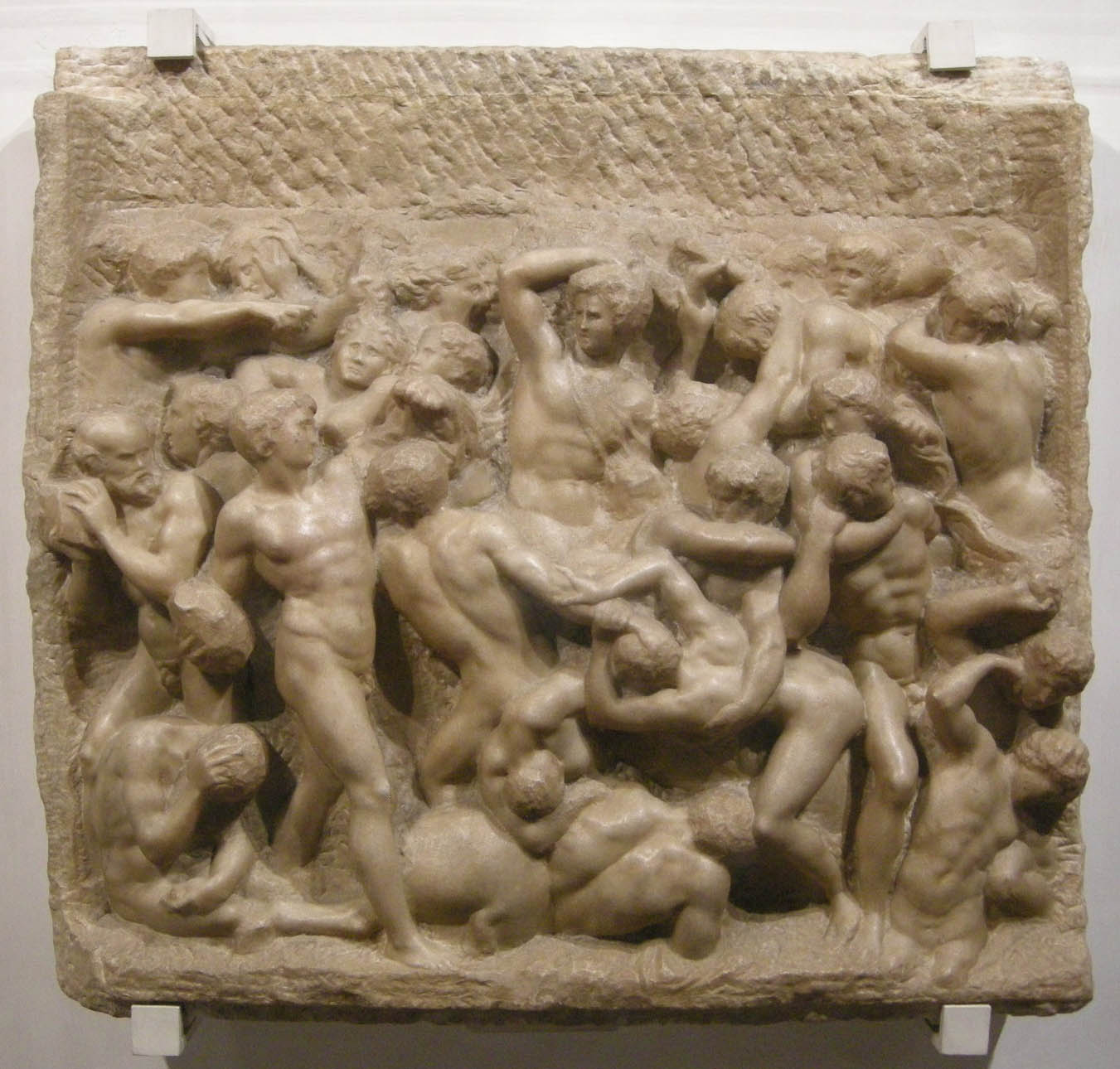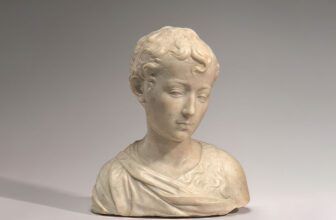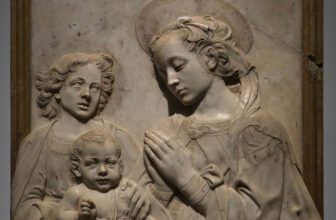
Meaning of The Battle of the Centaurs: Michelangelo
In the grand tapestry of Renaissance art, few works shimmer with the same youthful genius and mythological depth as The Battle of the Centaurs, an early marble relief by Michelangelo Buonarroti. Although often overshadowed by his monumental achievements like the David, the Pietà, or the Sistine Chapel ceiling, The Battle of the Centaurs is a work that reveals not only the raw, explosive talent of a young prodigy, but also his philosophical concerns, artistic rebellion, and lifelong devotion to the human form in motion.
This striking piece, sculpted when Michelangelo was only around 16 or 17 years old (circa 1492), is located today in the Casa Buonarroti Museum in Florence, Italy, Michelangelo’s ancestral home turned museum. Though unfinished, the sculpture has captivated artists, scholars, and historians for centuries. It is not simply a scene of mythological violence, but a timeless metaphor for inner conflict, classical rebirth, and the untamed power of human potential.
The Battle of the Centaurs is a high relief sculpture carved in marble, measuring approximately 84 x 90 cm (33 x 35 inches). It depicts a chaotic melee between centaurs, the half-man, half-horse creatures of Greek mythology, and Lapiths, a race of humans. Limbs tangle, muscles flex, bodies twist. There are no clear distinctions between individual fighters; rather, the composition reads as a swirling, organic dance of strife and fury.
What makes the sculpture even more intriguing is its unfinished state, a characteristic that Michelangelo would revisit in many of his later works. The rough, almost sketch-like quality of the marble gives the impression that the figures are still struggling to emerge from the stone. In this sense, the sculpture is not just a representation of a battle, but a battle with the stone itself.
A Young Genius in Florence
Michelangelo carved The Battle of the Centaurs while studying under Lorenzo de’ Medici, the de facto ruler of Florence and one of history’s most influential patrons of the arts. Lorenzo the Magnificent recognized Michelangelo’s extraordinary promise early on and invited him to live in the Medici palace, exposing him to the greatest thinkers, artists, and philosophers of the Florentine Renaissance.
During this period, Michelangelo studied classical sculpture, particularly the marble reliefs of antiquity. One of his main inspirations was the ancient Sarcophagus of the Centaurs, a Roman relief housed in the Medici collection. Encouraged by the Neoplatonic ideas of human perfection and the synthesis of Christian and pagan thought, Michelangelo began to craft his own mythological scene: a writhing, idealized battle that would reflect both his technical prowess and his intellectual engagement with classical culture.
What Does The Battle of the Centaurs Represent?
At a literal level, the sculpture depicts the mythical battle between the Lapiths and the Centaurs, an episode from Greek mythology, particularly from the wedding of Pirithous and Hippodamia. According to the myth, the Lapiths invited the centaurs to the wedding feast, but the centaurs, drunk on wine and primal lust, attempted to abduct the bride and other female guests. What followed was a violent clash between civilization and barbarism.
Civilization vs. Savagery
This myth, widely popular in ancient art and revived in the Renaissance, represents the eternal conflict between order and chaos, reason and instinct, culture and nature. The centaurs, being half-animal, symbolize unrestrained desire and brute force. The Lapiths stand for human reason, honor, and social order. In Michelangelo’s version, however, the lines are blurred, both groups are depicted with idealized male forms, emphasizing not their differences, but their shared humanity and volatility.
Inner Struggle and the Human Condition
More profoundly, The Battle of the Centaurs is thought to represent the inner struggle of the soul, a key theme in Neoplatonism, which deeply influenced Renaissance thinkers. The battle could be interpreted as the conflict within every human being: the rational soul battling the animal passions. This interpretation gains even more depth when considered alongside Michelangelo’s later works, many of which deal with torment, striving, and the incomplete.
Symbolism in The Battle of the Centaurs
Michelangelo’s relief is rich in symbolism, much of it embedded not just in the myth but in the style and form of the sculpture itself.
1. The Unfinished Surface (Non-Finito)
One of the most significant symbolic elements is that the sculpture is unfinished. Rather than detracting from the work, this quality has become central to its meaning. Michelangelo’s later works, including the Prisoners or Slaves series, share this “non-finito” quality. The unfinished figures appear to be struggling to free themselves from the marble, echoing the philosophical idea that the human soul is trapped in the material world, yearning to return to the divine.
In The Battle of the Centaurs, the rough textures, unpolished areas, and incomplete limbs speak to the futility of violence, the ephemerality of human effort, and the perpetual incompleteness of human nature.
2. Intertwined Forms
The way Michelangelo intertwines the figures is almost sculptural choreography. There are no horses, no weapons, and barely any space between the combatants. The forms are interdependent, suggesting that the opposing forces, civilized and savage, reason and passion, are in fact two sides of the same coin. The battle is not just external, but internal and eternal.
3. Classical Ideals Reimagined
The muscular, nude bodies of the figures reflect Michelangelo’s reverence for classical antiquity and the idealized human form. He does not depict them realistically as a chaotic brawl but uses ideal proportions and heroic poses even in the thick of battle. This idealization adds a moral or philosophical dimension to the violence, it is not just a brawl; it is a metaphor for striving, struggle, and ultimately, transcendence.
Why Is The Battle of the Centaurs Famous?
While The Battle of the Centaurs is not as universally recognized as some of Michelangelo’s other masterpieces, it is highly significant in several key ways:
1. A Testament to Youthful Genius
This sculpture was created when Michelangelo was still a teenager. Even then, he demonstrated a precocious mastery of anatomy, spatial composition, and emotional intensity. It was so well-received that it caught the attention of other Florentine artists and patrons, launching his career.
2. A Break from Tradition
Unlike the conventional relief sculpture of his time, which often relied on linear perspective and flatness, Michelangelo broke the mold. He treated the marble relief like a painting in stone, carving deeply and allowing limbs to project boldly from the background. This three-dimensionality added a visceral energy to the piece and marked a radical departure from the norms of Florentine sculpture.
3. Philosophical Depth
The Battle of the Centaurs reveals Michelangelo’s early immersion in humanist philosophy, particularly Neoplatonism, which sought harmony between the spiritual and the material. This intellectual underpinning gives the work a resonance that goes far beyond its mythological subject.
4. An Early Glimpse of Later Themes
Many of Michelangelo’s later themes, struggle, the unfinished, the power of the male body, the soul’s torment, the tension between divine and earthly, are already present here. For art historians, this work is like a blueprint of the master’s inner world.
5. A Personal Favorite
Michelangelo himself considered The Battle of the Centaurs one of his finest early works. According to some accounts, he even kept it in his home throughout his life, a rare act for an artist often commissioned and separated from his creations. This speaks to how deeply personal and important this work was to him.
Where Is The Battle of the Centaurs Located Today?
The sculpture is housed in the Casa Buonarroti, a museum in Florence, Italy, dedicated to the life and legacy of Michelangelo. Located on Via Ghibellina, this historical building was once owned by the Buonarroti family and now serves as a repository of Michelangelo’s early works, sketches, and personal letters.
In the Casa Buonarroti, The Battle of the Centaurs is prominently displayed as a cornerstone of the collection, offering visitors a rare glimpse into the nascent brilliance of one of history’s greatest artists.
An Eternal Struggle in Marble
The Battle of the Centaurs is more than just a mythological depiction carved in stone. It is an autobiographical statement, a philosophical meditation, and a technical triumph. Michelangelo did not merely recount a tale from ancient lore, he sculpted a living allegory of human conflict, inner turmoil, and the eternal tension between form and chaos.
In the unfinished grooves and tangled limbs, we see a young artist grappling not only with the stone before him but with the very nature of human existence. The sculpture endures because it speaks to something timeless: the battle within every soul between our higher aspirations and our baser instincts.
And in that battle, as in the marble itself, Michelangelo found beauty, not in perfection, but in the striving.




